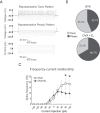Electrophysiology of arcuate neurokinin B neurons in female Tac2-EGFP transgenic mice
- PMID: 24735328
- PMCID: PMC4060187
- DOI: 10.1210/en.2014-1065
Electrophysiology of arcuate neurokinin B neurons in female Tac2-EGFP transgenic mice
Abstract
Neurons in the arcuate nucleus that coexpress kisspeptin, neurokinin B (NKB), and dynorphin (KNDy neurons) play an important role in the modulation of reproduction by estrogens. Here, we study the anatomical and electrophysiological properties of arcuate NKB neurons in heterozygous female transgenic mice with enhanced green fluorescent protein (EGFP) under the control of the Tac2 (NKB) promoter (Tac2-EGFP mice). The onset of puberty, estrous cyclicity, and serum LH were comparable between Tac2-EGFP and wild-type mice. The location of EGFP-immunoreactive neurons was consistent with previous descriptions of Tac2 mRNA-expressing neurons in the rodent. In the arcuate nucleus, nearly 80% of EGFP neurons expressed pro-NKB-immunoreactivity. Moreover, EGFP fluorescent intensity in arcuate neurons was increased by ovariectomy and reduced by 17β-estradiol (E2) treatment. Electrophysiology of single cells in tissue slices was used to examine the effects of chronic E2 treatment on Tac2-EGFP neurons in the arcuate nucleus of ovariectomized mice. Whole-cell recordings revealed arcuate NKB neurons to be either spontaneously active or silent in both groups. E2 had no significant effect on the basic electrophysiological properties or spontaneous firing frequencies. Arcuate NKB neurons exhibited either tonic or phasic firing patterns in response to a series of square-pulse current injections. Notably, E2 reduced the number of action potentials evoked by depolarizing current injections. This study demonstrates the utility of the Tac2-EGFP mouse for electrophysiological and morphological studies of KNDy neurons in tissue slices. In parallel to E2 negative feedback on LH secretion, E2 decreased the intensity of the EGFP signal and reduced the excitability of NKB neurons in the arcuate nucleus of ovariectomized Tac2-EGFP mice.
Figures







References
-
- Young J, Bouligand J, Francou B, et al. TAC3 and TACR3 defects cause hypothalamic congenital hypogonadotropic hypogonadism in humans. J Clin Endocrinol Metab. 2010;95:2287–2295 - PubMed
-
- Chawla MK, Gutierrez GM, Young WS, 3rd, McMullen NT, Rance NE. Localization of neurons expressing substance P and neurokinin B gene transcripts in the human hypothalamus and basal forebrain. J Comp Neurol. 1997;384:429–442 - PubMed
-
- Rance NE, Young WS., 3rd Hypertrophy and increased gene expression of neurons containing neurokinin-B and substance-P messenger ribonucleic acids in the hypothalami of postmenopausal women. Endocrinology. 1991;128:2239–2247 - PubMed
Publication types
MeSH terms
Substances
Grants and funding
LinkOut - more resources
Full Text Sources
Other Literature Sources
Molecular Biology Databases

